Nestled amidst the foothills of the Sierra Nevada, Don Pedro Reservoir stands as an angler’s haven, offering a sprawling 13,000-acre canvas kissed by the California sun. This expansive gem, known for its stunning granite cliffs and crystal-clear waters, unveils a diverse array of fish species, promising an unforgettable fishing experience.
📈 Latest Fish Plants
Fish here often?
How To Read Fish Plant Graphs
To interpret fish plant graphs effectively, consider the following key elements:
- Blue Vertical Bars and Numbers:
- Representation: The blue vertical bars on the graph represent individual fish plants.
- Weight Measurement: The associated numbers indicate the total weight of the plants in pounds (lbs.) that occurred during a specific week.
- Significance: Monitoring these bars helps identify weeks with higher planting activity, aiding anglers in selecting optimal times for fishing near recent plantings.
- Orange Trend Line:
- Purpose: The orange trend line represents the moving average of all fish plant activities at the specified location.
- Indicator of Activity: A rising trend line suggests a consistent increase in planting activity over the designated period. This indicates the potential for more catch opportunities and signifies a growing fish population over the weeks.
- Interpreting the Moving Average:
- Upward Trend: A rising moving average implies an upward trajectory in planting activity, indicating an increasing number of fish being introduced into the area. This suggests a positive outlook for anglers, as it implies a larger and potentially more accessible fish population.
- Downward Trend (Not Specified): The description does not provide information on the interpretation of a decreasing trend in the moving average. It might be beneficial to include information on what a decreasing trend could signify in terms of fishing prospects.
- No Data Present:
- Possible Explanations: If no data is visible on the graph, it may indicate that the location had no fish plants in the last three months. Alternatively, the absence of data could be due to non-disclosure of fish plants for that location.
- Natural Population: Some fishing areas in California rely on the natural growth of fish populations, and graphs may not show plants if this is the case.
- Graph Disclaimer:
- Data Source: The graphs reflect a combination of publicly disclosed data and estimates. Some locations may disclose fish plants without specifying exact amounts.
- Not Universal: Not all fishing areas have fish plants, and the natural growth of fish populations plays a significant role in many California fishing locations.
Understanding these elements will empower anglers to make informed decisions about when and where to fish based on historical fish plant data.
Note: If no data is present in the graph above, this location may not have had any plants the last 3 months, or may not have publicly disclosed plants. Graphs reflect both publicly disclosed data and estimates, as some locations disclose plants, but not exact amount.
🗺️ Map & Fishing Location
Fish to Expect:
- Striped Bass: The undisputed stars of Don Pedro, these formidable fighters can reach up to 65 pounds. Lurking in the depths near the dam and river mouth, they provide an adrenaline-pumping challenge. Look for boils, cast anchovies, sardines, or jigs, and brace yourself for an epic battle.
- Largemouth Bass: Ambush predators, these bass lurk in shallows and weed beds. Crankbaits, spinnerbaits, and Senkos prove effective in luring them out for an exciting encounter.
- Trout (Rainbow, Brown & Kokanee): Don Pedro’s cooler waters harbor a variety of trout species. Trolling near the dam, coves, and the main channel during spring and fall can yield hefty rainbow and brown trout. Kokanee salmon, some of the state’s largest, add to the thrill.
- Catfish & Crappie: Channel catfish patrol the bottom, responding to worms, anchovies, or nightcrawlers. Evenings near the dam or river mouth can be productive. Crappie enthusiasts can try minnows and jigs near docks, trees, and underwater structures for a rewarding catch.
Local Insights:
- Mouth of the Trench: North of Fisherman’s Point, this spot is a honey hole for stripers, especially during shad migrations.
- Rock Wall: Casting alongside the O’Neill Dam offers consistent depths and striper action.
- Dinosaur Point & Basalt Areas: Bank fishermen swear by these spots for bass, catfish, and crappie.
Unique Things to Note:
- Seasonal Shifts: Fish behavior aligns with water temperatures. Spring and fall emerge as prime times for striper and trout, while summer evenings witness heightened bass activity.
- Wind & Water Levels: Strong winds can stir up the water, making fishing challenging. Check conditions before heading out. Fluctuating water levels influence structure and fish locations.
- Boating Traffic: Exercise caution around boats, especially near the dam and popular launch areas.
Specific Locations:
- Cottonwood Point: Ideal for bank fishing, with easy access and striper hotspots near the mouth of the San Luis Creek.
- O’Neill Dam Recreation Area: Offers a boat launch, bank fishing, and ample space to spread out.
- Tuleburg Recreation Area: Primarily for bank fishing, featuring coves and shallows ideal for bass and crappie.
Don Pedro Reservoir transcends the label of a mere fishing hole; it’s an adventure waiting to unfold. Grab your rod, soak in the San Joaquin sunshine, and let the beauty and diverse fish populations of Don Pedro Reservoir reel you in.
Remember, always adhere to local regulations, be mindful of the environment, leave no trace, respect wildlife, and fish responsibly. Tight lines!



